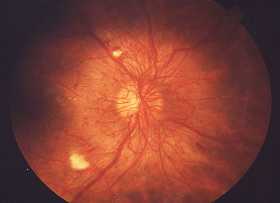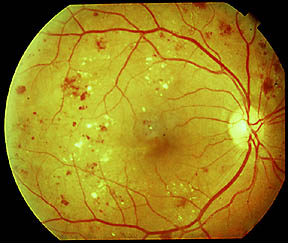-
Proliferative Diabetic Retinopathy
As the Diabetic Retinopathy progresses, severe nonproliferative diabetic retinopathy enters an advanced, or proliferative (PDR), stage when blood vessels proliferate (i.e. grow). The lack of oxygen in the retina causes fragile, new, blood vessels to grow along the retina and in the clear, gel-like vitreous humour that fills the inside of the eye. Without timely treatment, these new blood vessels can bleed, cloud vision, and destroy the retina. fibro vascular proliferation can also cause tractional retinal detachment. The new blood vessels can also grow into the angle of the anterior chamber of the eye and cause neovascular glaucoma.

During pregnancy, diabetic retinopathy may also be a problem for women with diabetes. It is recommended that all pregnant women with diabetes have dilated eye examinations each trimester to protect their vision.
Should the doctor suspect macular oedema, he or she may perform fluorescein angiography and sometimes OCT.
Management
There are three major treatments for diabetic retinopathy, which are very effective in reducing vision loss from this disease. In fact, even people with advanced retinopathy have a 90 percent chance of keeping their vision when they get treatment before the retina is severely damaged. These three treatments are laser surgery, injection of corticosteroids or Anti-VEGF into the eye, and vitrectomy.

Although these treatments are very successful (in slowing or stopping further vision loss), they do not cure diabetic retinopathy. Caution should be exercised in treatment with laser surgery since it causes a loss of retinal tissue. It is often more prudent to inject triamcinolone or Anti-VEGF. In some patients it results in a marked increase of vision, especially if there is an edema of the macula.
Avoiding tobacco use and correction of associated hypertension are important therapeutic measures in the management of poliferative diabetic retinopathy.
More on PDR
Location & Contact Details
© 2017 - 2024 Noel Templeton Optometrists



